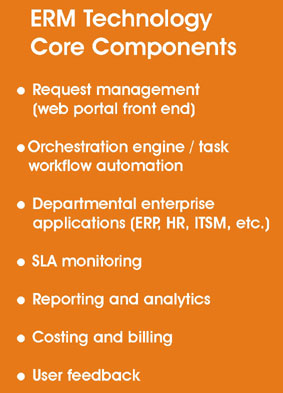What’s New at Kinetic: Building Smart in 2026
At Kinetic, we believe the future of Business Process Management isn’t bigger—it’s smarter.
As noted here previously, enterprise request management (ERM) offers a better approach to managing service requests and fulfillment than typical “siloed” functional methods. With ERM, customers...

As noted here previously, enterprise request management (ERM) offers a better approach to managing service requests and fulfillment than typical “siloed” functional methods. With ERM, customers (whether internal or external) can request any type of enterprise shared service (including services that span multiple functional groups) through a single, intuitive web-based and mobile-friendly portal interface.
The portal connects to core enterprise and departmental applications (ERP, ITSM, finance, HR, facilities management, etc.) using workflow automation software—an orchestration engine that automates approvals, scheduling, service delivery and other tasks by communicating with and between those core systems, and display status updates back through the portal front-end.
 At a high level then, the three core elements of the ERM technology architecture are:
At a high level then, the three core elements of the ERM technology architecture are:
Request portal software, which enables users to order any type of service provided, anytime from any device.
Workflow automation software for enterprise application integration (EAI), which communicates between the portal and other enterprise and department applications to automate approvals, scheduling and other tasks.
Core enterprise and departmental software systems, which store and manage data about users, schedules, resources, facilities, costs, locations and other elements.
Evaluating ERM technology requirements in more detail reveals the need for specific functionality to support elements of the ERM model. For example, applications required to support analytics for process measurement and continual improvement include:
Workflow automation software, which can automatically record and track key metrics such as elapsed time for task completion, in addition to communicating between applications;
Survey management or enterprise feedback management (EFM) software to collect user feedback on both quantitative and qualitative measures;
Service performance monitoring and reporting tools to collect and display data such as number of incidents created and SLA performance; and
Business intelligence (BI) and analytics applications which aggregate metrics for management reporting and system performance evaluation.
An ERM strategy provides several compelling benefits to enterprises, including reduced service costs; improved first-time fulfillment; accelerated service delivery; and a better user experience.
Most organizations will need to make some new technology investments in order to implement ERM. But the good news is that many of the core capabilities needed are already in place in most instances. ERM is designed to extend and leverage existing technology investments, rather than requiring an expensive and disruptive “rip and replace” approach.
For more details about the technology requirements for ERM, download the white paper The Technology Behind Enterprise Request Management.

At Kinetic, we believe the future of Business Process Management isn’t bigger—it’s smarter.

IT support automation uses software workflows, rule engines, AI/ML, and integrations to automate...

Business process reimagined is the strategic renewal of how work gets done by combining modern digital...